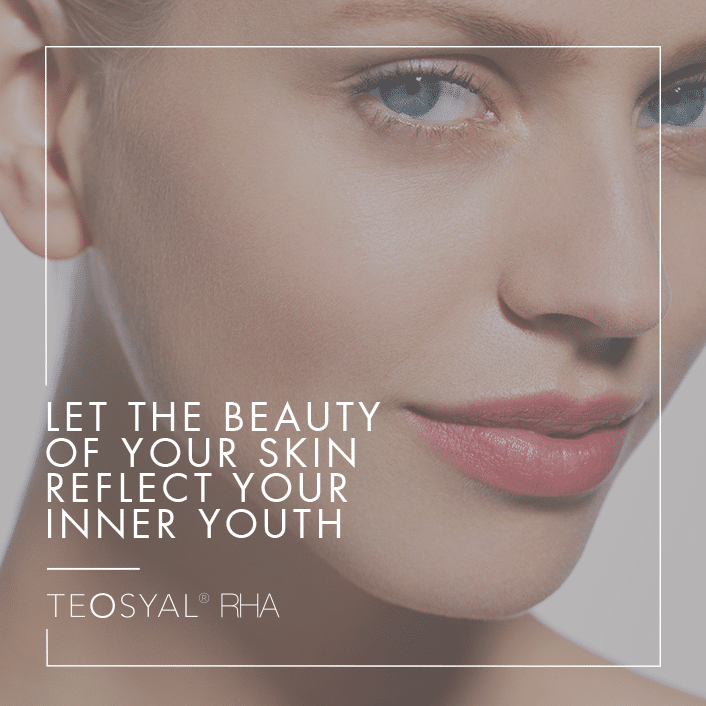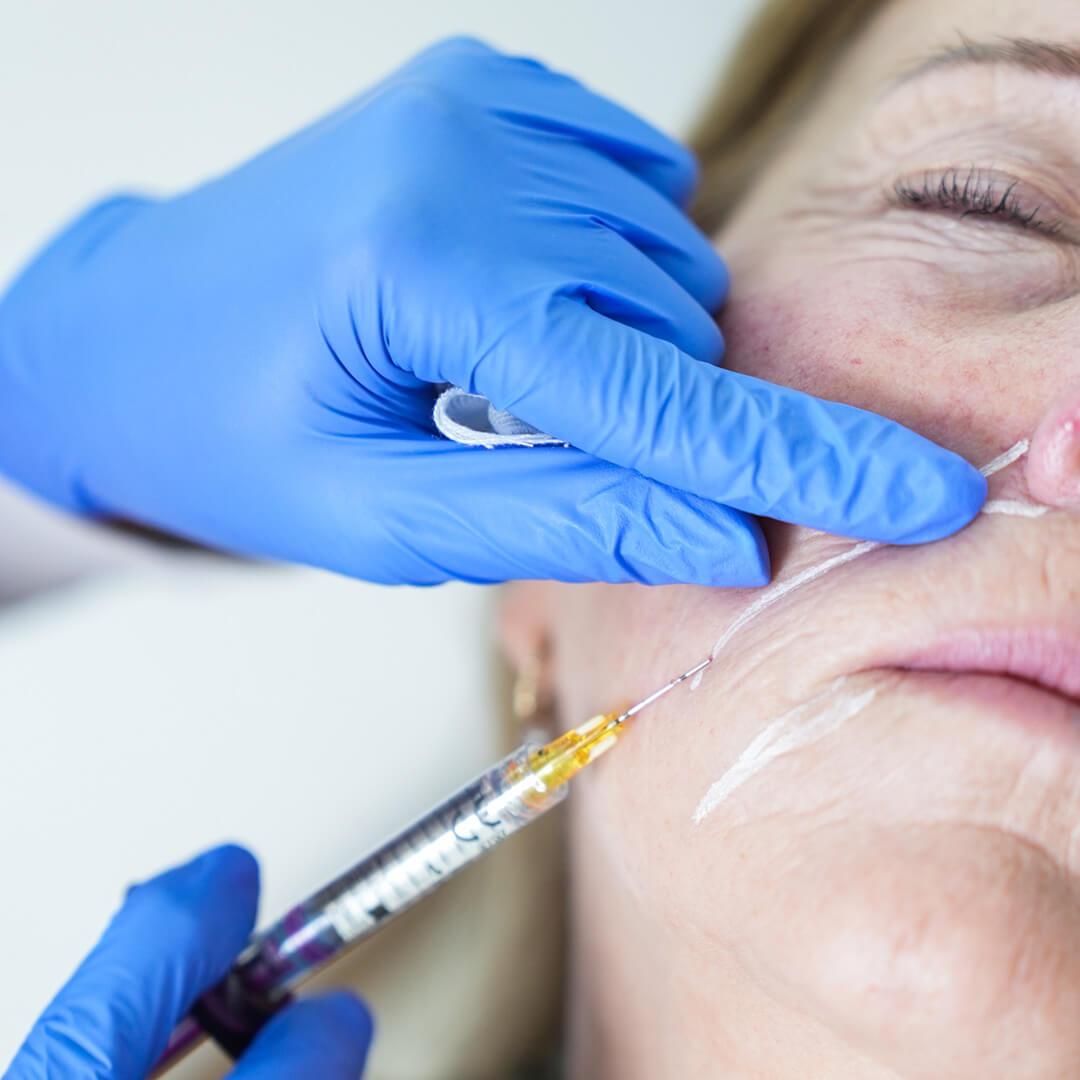WE RECOMMEND THAT YOU AVOID FILLER TREATMENTS 2 WEEKS BEFORE THE COVID VACCINE AND 4 WEEKS AFTER.
PLEASE NOTE, IF YOU ARE OFFERED THE COVID VACCINE, PLEASE DO NOT POSTPONE/DELAY. THE VACCINE IS A PRIORTY IN COMPARISION TO A FILLER TREATMENT.
What are Dermal fillers?
Dermal fillers are made up of Hyaluronic acid; a naturally occurring sugar chain molecule found in all skin and soft tissues throughout the body. They are manufactured, usually through fermentation and cross-linking with hyaluronic acid proteins to produce a clear, sterile gel for injection into the skin. Hyaluronic acid is responsible for skin hydration and elasticity, and this contributes to smooth, well-defined and plump features. As we age, the amount of hyaluronic acid in our skin depletes, causing the skin to loose volume and sag.
In the UK, there are over 160 brands on the market due in some part to weak regulation. Not all hyaluronic acids are the same and each brand has a range of ‘tissue tailored’ products designed for specific results. One size does not fit all. At FaceKind we use only tried, tested and reputable brands.
How do dermal fillers work?
Dermal fillers reduce wrinkles and deep lines, restore volume, smooth contours, and fill hollows of the skin. Hyaluronic Acid based dermal fillers provide instant correction. The hyaluronic acid attracts and binds water in the skin to add volume and hydration, as well as ‘cushioning’ and supporting collagen and elastin fibres. Dermal fillers are used to correct or enhance facial contours such as the cheeks, jawline, nose, chin and temples. They can also define and volumize lips and soften and correct facial wrinkles or folds. They can also be used to improve the tone, texture, and hydration of the skin.
Is the procedure painful?
Dermal filler procedures need not be painful. Most leading filler brands contain a local anaesthetic and we will apply topical anaesthetic cream, prior to treatment to numb the skin if appropriate. On request we can also provide infiltration anaesthesia (dental block) for lip filler procedures.
Are there any side effects?
Most people can continue with normal activities with immediate improvement in their appearance. Some patients will experience redness, pinprick marks and possible swelling/bruising – particularly in the lips. A stinging, tingling or burning sensation and injection site bleeding around the treated area is not uncommon. If analgesics are required to relieve tenderness, consider paracetamol rather than anti-inflammatory drugs.
Any swelling and bruising may be more apparent the next day. Swelling may worsen in the first 24 hours, and then should settle within the first few days. Cold packs and antihistamines can be helpful in reducing swelling and arnica cream/tablets to help with any bruising. Because of swelling, the product may feel harder or lumpy and you may notice some asymmetry, nonetheless this is usually temporary and will improve with time. The result may be judged at 2 weeks. Please do not hesitate to contact us if you have any concerns.
How long will the results last?
Hyaluronic acid fillers are temporary in nature and will degrade over time. Longevity does vary between products, and between individuals, but most will last between 6 months and 18 months. If you choose not to maintain the results with further treatment, your skin will return to its pre-treatment state over time. The results can often be seen immediately after injection, nonetheless you should allow up to weeks to judge the result.
Treatment summary
Procedure time:
30-60 mins
Pain level:
mild discomfort
Results:
Instant
Longevity:
6-18 months (dependant on treated area, filler thickness, patient metabolism etc)
Price:
from £170
Cheek Augmentation
At FaceKind we believe in treating the face holistically and share the ethos of injecting higher up to lift, smooth and anchor the lower half of the face. For instance, sculpting the cheeks creates a ‘lifting’ effect which in turn minimises signs of ageing lower down in the face such as the nasolabial folds. This coincides with the age-old saying, “Treat the cause, not the problem”. Cheek augmentation creates a more refreshed and youthful appearance, whilst also giving the face a contoured, yet natural look. Results last from between 12 to 18 months.
Lip Enhancement
Non-surgical lip enhancement involves injecting soft filler to add volume to thin lips, regain plumpness and strengthen the outline of the lip border, often taken away by aging. It is believed that 50% of our lip volume depletes by the age of 50. Furthermore, lip filler treatments can correct asymmetry and create a more harmonious balance between the upper and lower lips. Lip fillers are also a great treatment if you suffer with bar code lines in the white of the upper lip. The added structure resulting from lip fillers helps to support the upper lip and prevent worsening of bar-code lines. Results will generally last up to 6 months.
Nose to mouth lines (Nasolabial folds)
Often referred to as ‘smile lines’, Nasolabial folds are the creases than run from either side of the nose down towards the corners of the mouth. This occurs because of a reduction in fat pad as well as a loss of volume from the cheeks. Results vary dependent on the type of filler, usually between 10-18 months. We will always look at the root cause of the naso-labial folds and where possible treat this first. E.g replace lost volume in the cheeks first, which often reduces the appearance of smile lines. The type of filler used here varies depending on the depth of the folds and we take on a ‘less is more approach’ with this treatment to maintain a natural looking result.
Mouth to chin lines (Marionette lines)
The marionette lines transverse from the corners of the mouth down towards the chin and give the appearance of a sad expression. These folds can progress to form jowls later in life. With the use of dermal fillers and correct technique, the added volume at the corner of the mouth creates a lifting effect resulting in a more youthful appearance. Results vary dependent on the type of filler, usually between 10-18 months.
Non-surgical rhinoplasty (‘Nose job’)
A non-surgical rhinoplasty is an advanced procedure that involves strategically injecting filler into the nose to address irregularities and create a more harmonious profile. It is possible to disguise bumps to create a straighter appearance, raise a flattened bridge to contour the nose and lift the tip of a droopy/hooked nose in minutes. There is a misconception that adding filler in the nose will make it appear bigger, but performed correctly the nose can appear smaller, straighter and sharper. Non-surgical rhinoplasty is a great alternative to costly surgery and downtime is minimal in comparison. Results last on average for 12-18 months and the filler is naturally and slowly broken down over time.
The nose shares a special relationship with the lips and chin. It is not uncommon to address and augment these areas together and is otherwise known as a profiloplasty. During your consultation we will assess your nose as well as its relationship with the rest of your face before advising on a suitable treatment plan for you.
Tear trough fillers
Dark circles can be attributed to weight loss, stress, genetics or age. This leads to volume loss under the eye and subsequently the formation of a sunken hollow or indentation known as a ‘tear trough’.
The procedure involves placing a specific type of dermal filler under the eye to replace lost volume and lift a sunken tear trough. The filler also contains light-reflecting pigments as well as vitamins and minerals to lighten and brighten the tear trough over time. Although a difference is noticeable immediately after treatment, results will continue to improve over the next 2 weeks, at which point the final result can be judged.
Although an advanced procedure, tear trough treatment is relatively safe as we employ the use of a micro cannula (blunt needle) instead of a needle. This minimises bruising in the delicate eye area and makes the procedure quick and comfortable.
Replacing lost volume in cheek or midface can also improve the appearance of tear troughs and it may be suggested that this is carried out before attempting tear trough treatment.
Tear trough filler lasts for 9-12 months on average and the filler is naturally and slowly broken down over time.
Jawline and Chin filler
Jawline and chin filler often go hand in hand and is a great option for enhancing and balancing the profile of the face. Adding filler into the jawline has the effect of creating definition, shape and a smoother contour to the lower third of the face. Jawline filler is also effective in disguising the appearance of jowls, creating the illusion of a slimmer face, and is becoming increasingly popular for men who are seeking a more ‘masculine’ appearance. Chin filler can be used to lengthen the face and project the chin outwards to produce a more harmonious side profile. Volume loss in the chin is common with age and administering filler in this region can smooth out deficiencies to create a more refreshed appearance. Results last on average for 12-18 months and the filler is naturally and slowly broken down over time.
Temple fillers
The temples are an area of the face which are often neglected. The temples are a bony region with little volume but as we age/lose weight, the small amount of volume here also depletes. This affects the overall youthful appearance of the face with the face going from an oval shape to more of a ‘money-nut’ shape. This can age the face and look more skeletal. Correcting the temple concavity with dermal fillers will not only replace volume loss and create a fuller face but also provide a subtle lift to the eyebrows and eyelids. Teamed with cheek fillers (also known as ‘C’ curve rejuvenation) this provides a beautiful lift to the mid-face.
Smokers lines/bar code lines
Smoking or excessive use of the mouth area can lead to mild/moderate lines and wrinkles in the white of the upper lip. These are commonly known as bar-code lines/Smokers lines. The lines in this area of the face can be tricky to treat and often a multi-treatment approach is required for the most natural and effective result. One of these treatment options include the administration of dermal filler. A soft filler is administered in the bar code lines to replace the lost fat in this region as well as support the skin and underlying muscle. Depending on the extent of the wrinkles we may also recommend some skin booster sessions as well as Botulinum toxin to reduce muscle contraction. In addition, lip filler can be very effective in supporting the white roll of the upper lip and helps to prevent worsening of the lines.

